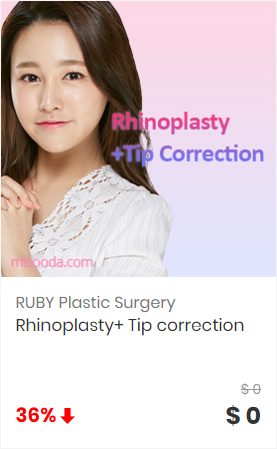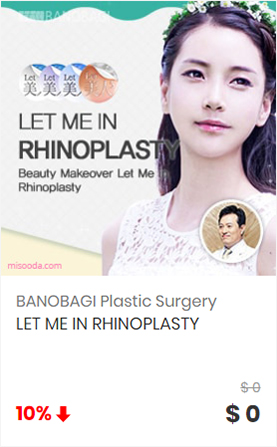Nose Surgery in Korea cost-Rhinoplasty material
See the nose ▼
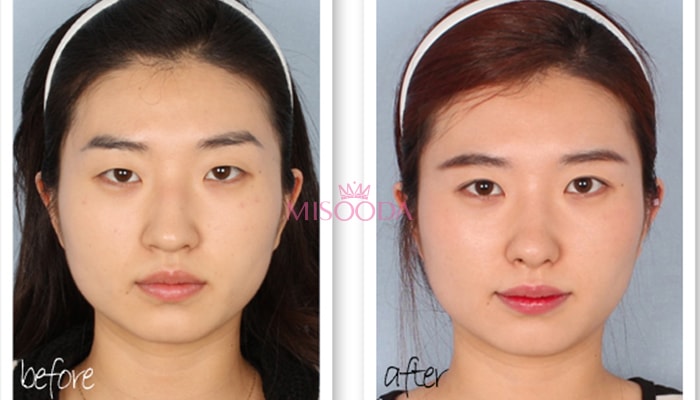
Rhinoplasty, commonly known as a nose job/ nose surgery, is a plastic surgery procedure for correcting and reconstructing the nose form and aesthetically reshaping or resizing the nose. It can correct a variety of concerns, including a visible bump on the nasal bridge, a droopy or bulbous nasal tip, a nose that’s off-center or deviated. However, the idea of nose surgery 2(Rhinoplasty) in Korea also called as an Asian Rhinoplasty, is designed to give a “Western” appearing nose by enhancing and reshaping the nasal bridge and tip.
Here is the most common nose surgery procedure,
Latest Trend of Rhinoplasty in Korea
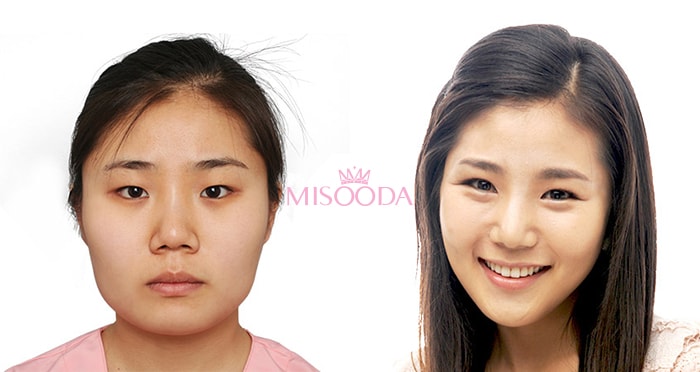
The nose is the most prominent feature on the face. Therefore, it is one of the most important facial features that determine the overall impression of one’s look. A tall and high nose alone cannot be the standard of a beautiful nose. Natural-looking nose which harmonizes with the overall facial proportion is as important as making a high nose.
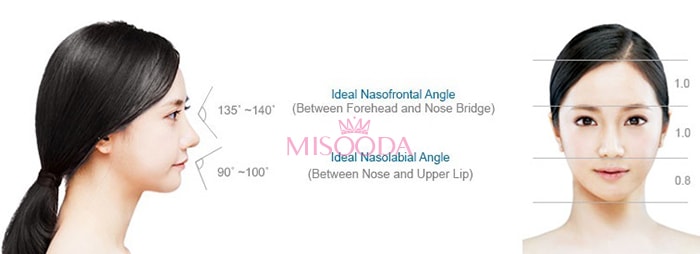
The perfect ratio of a beautiful nose is the consideration of the nose length, nasofrontal angle (between forehead and nose bridge) and nasolabial angle (between nose and upper lip). The ideal nose length takes up about one third of the face. The ideal angle of nasofrontal is about 135~140 degree which matches along the nasolabial angle, 90~100 degrees.
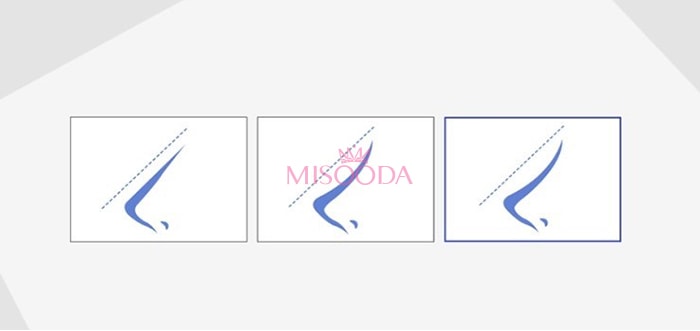
The nose shape preference has changed over generations. Back then people only preferred a straight and high nose but now there are straight, curvy or straight-curvy nose shapes that people can choose from. The nose shape also needs to be decided after considering patients ideal nose and the overall facial harmony.
Who are the candidates for nose surgery/rhinoplasty?
- Those who have flat/low noses
- Those with a humped nose, an upturned nose, a bulbous nose, a deviated nose, long nose, and wide nasal bridge
- Those with deviated nasal septum
- Those with wide alar and bulbous nose tip
- Those who want to change their image that they already have
Here are the nose surgery procedures what these candidates need, case by case:
- Nose Augmentation
- Flat nose
- Bulbous nose
- Hump nose
- Short nose
- Long nose
- Deviated nose
- Alar reduction
- Revision Rhinoplasty
Implant

Silicone: Silicone implant is the most common and longest used type of implant for rhinoplasty. It does not absorb nor does it change in shape even after a long lapse of time. In addition, it is easy to mould silicone into various shapes, considering the patient’s facial characteristics. If the patient’s skin is too thin, the implant may be seen through the skin. Proper implants should Silicone: Silicone implant is the most common and longest used type of implant for rhinoplasty. It does not absorb nor does it change in shape even after a long lapse of time. In addition, it is easy to mould silicone into various shapes, considering the patient’s facial characteristics. If the patient’s skin is too thin, the implant may be seen through the skin. Proper implants should be used considering the patient’s skin thickness and conditions.be used considering the patient’s skin thickness and conditions.

Gore-Tex: Gore-Tex, widely applied to vascular surgery, has been proven to be safe. As Gore-Tex is softer than Silicone implant, it can be used for those who have thinner skin. In addition, it looks very natural after an operation. Gore-Tex easily assimilates into the tissues and develops few complications such as foreign body reactions due to its microscopic holes. Because of its soft texture, it is difficult to sculpt it into a desired shape or to insert it into the proper location.
Silitex: Silitex is an implant consisting of silicone on the front and thin Gore-Tex on the rear. It has the advantages of both silicone and Gore-Tex. Since bearing capacity is high, there is no risk of lowering the height of the nose bridge. So, the height Alloderm: Human dermis is processed to prevent rejection reactions. If the patient has extremely thin skin, Alloderm may be added to the top of an implant to reduce the see-through phenomenon. It is thin and partially absorbable. Alloderm is expensive so it’s not appropriate to use in a simple rhinoplasty context. and shape of nose bridge stays well. It is normally difficult to remove when doing revision surgery.
Artificial tissue

Alloderm: Human dermis is processed to prevent rejection reactions. If the patient has extremely thin skin, Alloderm may be added to the top of an implant to reduce the see-through phenomenon. It is thin and partially absorbable. Alloderm is expensive so it’s not appropriate to use in a simple rhinoplasty context.
Medpor: Medpor is a replacement or additional material for Septal cartilage when the nose tip is augmented. This material has more possibility of infection so it is not suitable for everyone. One disadvantage is that it is difficult to remove if a revision surgery has to be done because it sticks to the tissues.
Autologous tissue
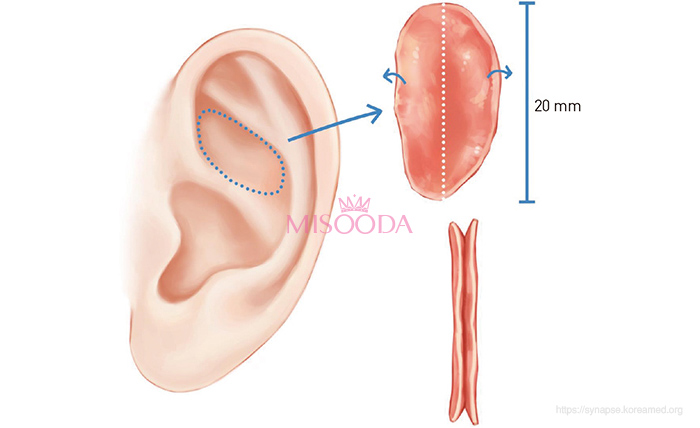
Ear Cartilage: They are generally used for nose tip augmentation. It doesn’t break easily and can make multiple layers with it. The cartilage is curved so making a natural-looking nose tip at any angle is possible however, since it is curved, one limitation is that there is only one point that holds the tip down firmly.
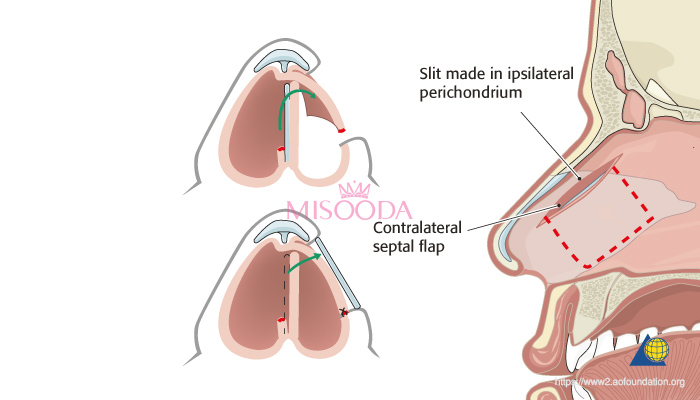
Septal Cartilage: It does not leave any scars or have any functional or structural problem after harvesting the septal cartilage. It is possible to correct a deviated nasal septum through rhinoplasty and also nasal stuffiness may improve. The nose tip is normally hard and doesn’t go upwards when pushed up (also known as the piggy nose move). Also, there is a limit on the amount of septal cartilage being harvested.
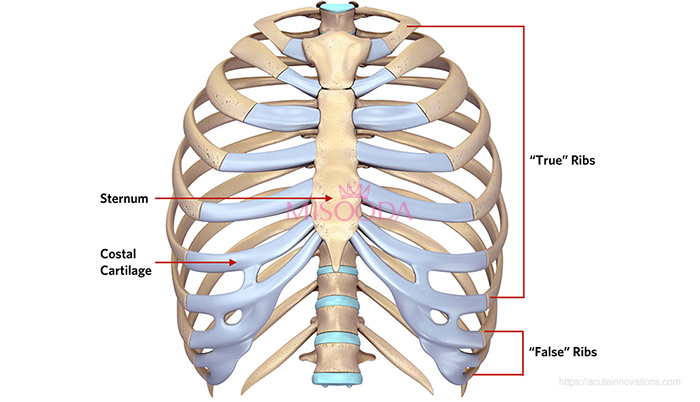
Rip Cartilage: There are abundant rib cartilages to be harvested. It is possible to produce a variety of shapes and lines. It can create a well-defined looking nose. Scars are visible at the rib cartilage harvested area (from 1-4 cm). You can feel that the nose is hard and may cause distortion after collection.
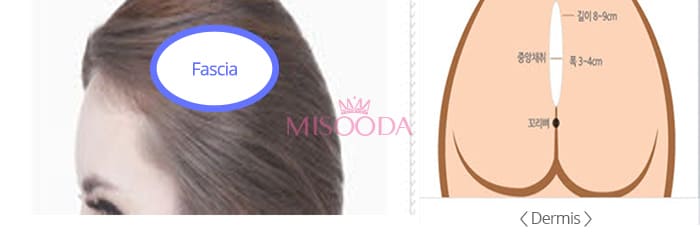
Fascia, Autologous dermis: Autologous dermis can be used when skin of nose bridge is damaged or very thin due to repetitive surgeries. Autologous dermis is collected from the buttock or groin or fascia from the scalp. It can be inserted on its own or inserted together wrapping the implant for nasal bridge augmentation in extremely thin skin cases. Since these are not foreign substances, they are safe and create a natural-looking nose. The fascia may be absorbed over time and the harvested site leaves a small scarring. Surgery is a little complicated with long operation time.
Korean Nose Surgery/ Rhinoplasty Cost
General price guide line for Korean Nose Surgery/ Rhinoplasty is USD$900 to USD$7,500 according to Korea Health Industry Development Institute. The price is decided depending on the method and difficulty of patients’ case. The procedures below can be added on the top of general nose augmentation and the price will be in variable range.
| Part |
From (USD) |
To (USD) |
|
Rhinoplasty (Silicone + cartilage) |
3,200 | 3,800 |
| Nostril Reduction | 900 | 1,800 |
| Aquiline Nose Rhinoplasty | 3,600 | 5,500 |
| Crooked Nose Correction | 5,500 | 7,300 |
|
Nasal Bone Reduction(Osteotomy) |
4,500 | 7,500 |
To learn more about Korean Plastic/Cosmetic surgery price in Korea, check Know your plastic surgery price.
To check various types of rhinoplasty procedures,
- Nose Augmentation
- Flat nose
- Bulbous nose
- Hump nose
- Short nose
- Long nose
- Deviated nose
- Alar reduction
- Revision Rhinoplasty
Nose Surgery Precautions
Preoperative Precautions
Check: What to prepare before Plastic Surgery
1. Swelling and bruises will occur for 3 days after the surgery but they will be gradually subside
afterwards.
2. Applying ice-pack for 2-3 days will be helpful. Apply the ice pack around the surgical area but not on
the nose bridge or nose tip.
3. Facial wash and make-up can be done the next day after surgery avoiding the nose area.
4. Please do not remove bandages or cast or cottons inside of your nostrils until a nurse does it.
5. Please avoid blowing your nose for 2 weeks. In case of a nosebleed, gently wipe out the blood. Please
avoid putting tissues inside your nostrils. It is normal to have a small amount of nose bleed for 2-3
days after the surgery.
6. Please avoid wearing sunglasses for 2 weeks in case of a simple rhinoplasty and for 4 weeks in case
of nasal bone reduction.
7. Please avoid heavy exercise such as aerobics, gym for 4 weeks. However, going for a walk is
recommended.
8. Shower can be done on the next day of the stitch removal, but please avoid sauna and hot spring for
4 weeks.
9. Please avoid bowing of the head or lying face down.
10. Supporting your head higher with large pillows is helpful in reducing swelling or pain. Do not turn
your neck sideways or lie face down, but try to sleep in a straight position as much as possible.
11. Please take the prescribed pain killers and antibiotics. In case you require additional pain killers,
take Tylenol (paracetamol), or medication that does not contain aspirin. Aspirin related pain
medication might cause bleeding, therefore is not recommended.
12. Drinking and smoking should be avoided for 4 weeks. Alcohol can cause infection and smoking can
damage/necrotize skin or delay wound recovery as it contracts vessels
